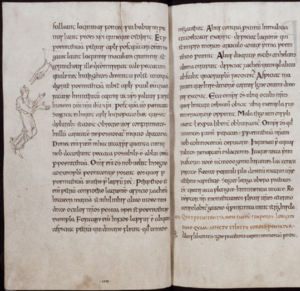Oxford, Bodleian Library, Bodley 718
| Library | Bodleian Library |
|---|---|
| Shelfmark | Bodley 718 (2632) |
| Century | saec. Xex-XIin (catalogue/Pächt-Alexander),
saec. X2-Xex (Gneuss), saec. X2 (Dumville), saec. X (Ker), saec. X-XI (Kerff/Kéry) |
| Provenance | ? |
| General region of origin | Exeter |
| Collection | Quadripartitus |
| Author | Bruno Schalekamp |
Oxford, Bodleian Library, Bodleian 718 (2632) is a late tenth to early eleventh-century manuscript of 182 folios in 1 col. (352 x 229 mm). Its codicological composition is unknown. The partially digitized version only confirms a single quire signature, IIII28. Modern foliation is in Arabic numerals. It was written in Exeter by multiple hands in Anglo-Saxon minuscule. According to Blair, the manuscript was in Dorchester after 1067 and five years later in Exeter. It was given by the Dean and Chapter of Exeter to the Bodleian library in 1602.
Contents
Oxford, Bodleian Library, Bodley 718 is a medium to large-sized codex and contains mostly canonical and penitential material. The former is dominated by the Collectio canonum Quadripartitus, the latter by Pseudo-Egbert's Penitential. The manuscript also includes a capitulary by Gerbald of Liège, as well as some patristic and conciliar excerpts, local entries on debts, an epistle of pope Leo IX and an excerpt of Gregory VI's decretal. The three books of the Quadripartitus have been transcribed by Elliott (see: http://individual.utoronto.ca/michaelelliot/). Unfortunately, the complete manuscript has not been digitized yet, but only partially (see: https://digital.bodleian.ox.ac.uk/objects/63138303-94a0-42d7-8bff-dba8bb4a52af/).

MS Oxford, BL, Bodley 718 contains - as far as I have been able to scrape from its partially digitized edition and found in descriptions or other works - various drawings in the margins of the base texts. These drawings can be found on fols. 28v, 49v, and 132v, of which the first two depict a lady, assumedly receiving absolution, and a king. The codex also includes various illuminated and visually complex capitals on fols. 1r, 24r, 53r, and 129r. According to Pächt-Alexander, the illuminations in the codex belong to the same group of illuminated codices as Oxford, Bodleian Library, Auct. F. I. 15 (2455) and Oxford, Bodleian Library, Rawl. C. 570.
| folios | texts |
|---|---|
| Front cover | |
| Irv | Chapters and title of the Penitential of Pseudo-Egbert of York |
| 1r-3r | Pseudo-Egbert's Penitential, prologue |
| 3r-5r | Gerbald of Liège' First Capitulary |
| 5r-21r | Pseudo-Egbert' Penitential |
| 21v | Blank page |
| 22r-178r | Collectio canonum Quadripartita (Quadripartitus), books 2-4 |
| 22r-50r | Book 2, including list of titles |
| 50r-121r | Book 3, including preface and list of titles |
| 121r-178r | Book 4, including prologue, list of titles, and epilogue |
| 178r-v | Excerpts of patristic works and conciliar law |
| 179r | Local entries in various hands concerning debts of laymen of Banbury, Thame, and Aylesbury. Late 11th century hand |
| 179v | Small probationes pennae |
| 180r | Short excerpt of papal decretal by pope Gregory VI, titled: Nullus episcopus grauamen... |
| 180v | Letter from pope Leo IX to king Edward the Confessor. Late 11th century hand |
| Back cover |
Literature
Aronstam, The Latin canonical tradition (1974), p. 34-35; Bateson, ‘A Worcester Cathedral Book’ (1895), p. 712, 714 and 721; Bateson, ‘The supposed latin penitential’ (1894), p. 320-326; Bethurum, ‘Archbishop Wulfstan’s Commonplace Book’ (1942), p. 916, 919, and 928; Blair, ‘Estate memoranda’ (2001), p. 114-123; Conner, Anglo-Saxon Exeter (1993), p. 38-39; Cubitt, ‘Archbishop Dunstan’ (2007), p. 162-163; Cubitt, ‘Bishops, priests and penance’ (2006), p. 58-59; Drage, Bishop Leofric (1978), p. 407-410; Dumville, Liturgy (1992), p. 82 n. 88, 85 n. 11, 90 n. 114, and 133-134; Fehr, Die Hirtenbriefe (1914, repr. 1966), p. xcix; Fournier, Le Bras, Histoire (1931), p. 317; Fowler, ‘Wulfstan’s Canons’ (1972), p. LVIII; Gameson, ‘The origin of the Exeter book’ (1996), p. 162-169 and 177-178; Gneuss, Handlist of Anglo-Saxon manuscripts (2001), no 592; Haggenmüller, Die Überlieferung (1991), p. 87-88; Hamilton, ‘Remedies’ (2005), p. 90; Holmquist, ‘Viking art in the eleventh century’ (1951), p. 6; Homburger, Die Anfänge der Malschule (1912), p. 3; Johnson, A Collection Vol. 1 (1850), p. 185, 187, and 223; Kendrick, Late Saxon, p. 18 and 131; Ker, Catalogue of manuscripts (1957, repr. 1990), p. 153 and 437; Ker, Medieval Libraries (1964), p. 85; Kerff, Quadripartitus (1982), p. 20-24; Kéry, Canonical Collections (1999), p. 167-199; Madan, Craster, A Summary Catalogue (1922), p. 459-461; Maassen, Geschichte (1870), p. 852 and 862; Mordek, Kirchenrecht (1975), p. 172 n. 356; Pächt-Alexander, Illuminated Manuscripts (1973), p. 36; Rice, English Art, p. 178; Schmitz, Bussbücher Vol. 1 (1883), p. 718; Selborne, Ancient Facts (1892), p. 230, 235-241, and 327-331; Temple, Anglo-Saxon manuscripts (1976), no. 30 (xiv); Webber, Scribes and scholars (1992), p. 92; West, ‘Legal culture’ (2010), p. 373-374; Wormald, Initials, p. 135.
See also Michael Elliot's extensive work on this particular manuscript, including a full transcription of the Quadripartitus on his own website: http://individual.utoronto.ca/michaelelliot/.
